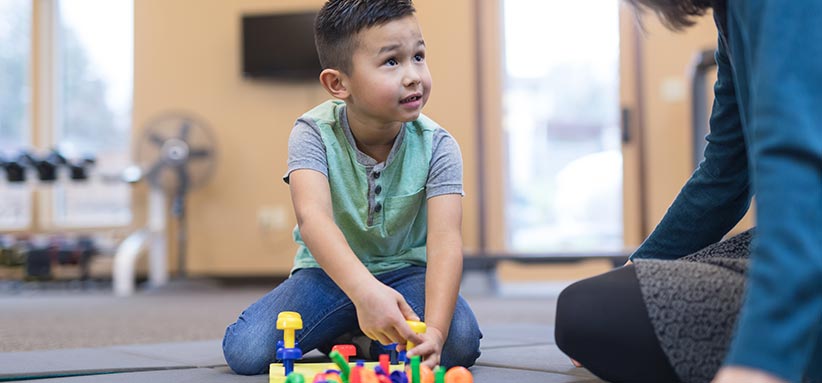Pediatric physiotherapy especially helps babies and children whose motor development is affected by a musculoskeletal, neurological or tone disorder. Through clinical treatments and exercises in the form of games to do at home, the physiotherapist will propose a treatment plan and give you advice to promote your child’s functional potential.

Why consult a pediatric physiotherapist?
Pediatric physiotherapy is different from general physiotherapy because it takes into account the motor development of the baby or child and the specificities of their body. You can consult pediatric physiotherapy if your child has one of the following conditions:
- Congenital or positional torticollis (preference for keeping the head turned or tilted to one side)
- Plagiocephaly or brachycephaly (flat head)
- Delay in motor development (to tolerate prone position, rolling over, sitting up, crawling, walking, running, etc.)
- Gait disturbance (on tiptoe, feet inward, etc.)
- Difficulty with coordination and balance
- Musculoskeletal impairment (clubfoot, congenital hip dislocation, etc.)
- Brachial plexus injury
- Cerebral palsy, encephalopathies, strokes and other neurological diseases
- Neuromuscular diseases (e.g. Duchenne muscular dystrophy)
Pediatric physiotherapists can also intervene with premature babies, who are often more affected by delays in their overall motor development than full-term babies. It is important to consider the baby's corrected age when discussing gross motor development. To calculate the corrected age, subtract the expected date of delivery from the current date.
What are the treatments used in pediatric physiotherapy?
Physiotherapists mainly use their hands to perform the different treatment techniques like stretching. They help kids activate the right muscles and perform the right moves so they can ultimately do those moves on their own. Positioning, or how to properly position the baby or child, is also often part of the treatment. Toys are used at all sessions to motivate the child.
Physiotherapists always teach the right techniques to parents so that they can repeat them at home and become the main players in the success of the treatment.
How does a pediatric physiotherapy session take place?
From the first appointment, the physiotherapist will assess your child in order to target the origin of the problem and propose an appropriate treatment plan. You will receive explanations about his condition, advice and exercises often in the form of a game to help him on a daily basis.
Before the meeting, you will have to fill out a questionnaire concerning your child's history including the course of pregnancy and childbirth, complications, associated diseases, motor development, habits, etc.
During the meeting, the physiotherapist will first ask you questions in order to fully understand your child's problem and your goals. She will carry out various physical tests in order to assess, for example, the amplitude and quality of her movements, her strength, her flexibility, her posture, her muscle tone, her level of motor development and her functional abilities, such as her way to move around, to make certain movements, to maintain a position, to use toys, etc.
Then, the physiotherapist will explain the results of her assessment and suggest a treatment plan. You will also discuss the frequency and approximate duration of future meetings. In addition to being part of the treatment, these follow-up meetings will be used to assess your child's progress and to adjust the exercises at home.
Your participation is essential to the development of your child, because you are the one who interacts with him or her most often. Your physiotherapist will therefore teach you the techniques to use and will accompany you throughout this process.


